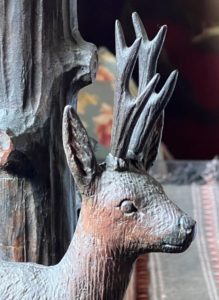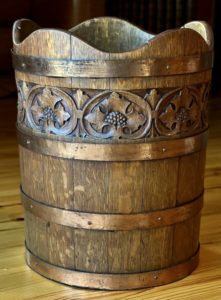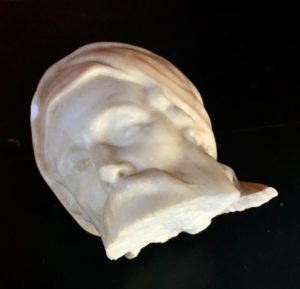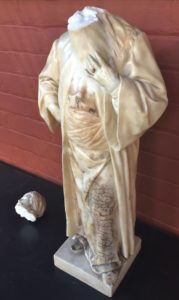Small Home Gazette, Spring 2022
The Quest for Restoration
Finding Someone to Repair a Vintage Treasure Can Be…Complicated
Do you have treasured objects in your home that are in need of repair or restoration? And are you at a loss as to where to get them restored?
Welcome to the club.
Over the years I have collected decorative pieces that I cherish. Some were imperfect when I purchased them, but they were so beautiful and/or cheap that I could not resist. Others sustained damage once I got them home. I have often wrestled with the question of whether to live with an imperfection; get rid of the item; or try to get it repaired.

This deer, part of a rustic lamp base, was missing one antler. We found a retired, amateur wood carver at a church craft sale, who carved a replacement for $40. Most restorations will be significantly more expensive.
For those objects I ventured to repair, I have learned three truths:
- Finding someone to repair an unusual vintage object is difficult.
- If you do find someone to repair it, it is going to be expensive.
- The repair is going to take longer than expected.
Some vintage items—such as lamps and light fixtures and old clocks—can be taken to specialty shops in the Twin Cities. (See “Vintage Lighting Sales, Repair and Restoration” from the Winter 2019 edition of this newsletter, and “Maintaining and Repairing Your Old Clocks” from the Summer 2021 edition.) But when it comes to more unusual decorative items, finding repair options takes some sleuthing.
So how do you find the right person to restore your treasure? And once you do, what should your expectations be? Here are a few suggestions gleaned from my experience and from talking to others:
- Search online for restoration services. This might seem obvious, but it is not always the first option that comes to mind for those of us who grew up depending on the Yellow Pages. Try web searches using a variety of words and phrases. Your object, or the service you are looking for, may be described using various terms.
- Ask others for recommendations. If the person you ask does not have a resource, they might steer you to someone else. In other words, network.
- Once you have found a potential restorer, contact them to see if they are able and willing to take on the job. I have found that they sometimes decline because they have more work than they can handle.
- Be ready to email several photos of your object that are well lit, sharply focused, and show the item from different angles. Include close-ups of the damaged areas.
- Ask for an estimated cost for repair, but be aware that the craftsperson might want to see the item firsthand before providing a quote.
- Be prepared to pay a higher price than you were expecting. The types of repairs we are discussing are not off-the-shelf fixes, where interchangeable pieces can be popped off and a new one snapped on. They usually require more time and skill than we realize. Or the law of supply and demand may apply—if there are few people who have the skills you are seeking and demand is high, you will pay more.
- If the craftsperson is not local, pack your item carefully before mailing it off. You do not want it to incur additional damage en route.
- Sit back and wait. And wait.
Also remember this: If you are restoring your object to increase its resale value—don’t bother, because it likely won’t. Unless you have one of those rarified antiques that pop up on PBS’ “Antiques Roadshow” that are appraised at jaw-dropping prices, you will not recoup your investment.

This nutcracker has been repaired. The squirrel was missing part of one ear. New wood was grafted onto the piece, then carved and stained to match.
“The reason to repair is not for resale value,” says Stillwater-based antiques dealer Carol Eppel (caroleppelantiques.com). “The value for most people is going to be in the emotional value for the owner, not a financial return.”
Brian Smith, co-owner of St. Paul antiques shop Eastwood Gallery (eastwoodgallery.com) agrees. For example, he says, getting a piece of furniture refinished or reupholstered will usually not pay for itself if you were to sell the piece. “The cost of reupholstering a sofa will almost always be more than a new sofa,” he says.
Eppel also articulated another point about value—that there are different levels of quality and price when it comes to restorations. You may opt for a fix that is “good enough” rather than “museum quality” depending on the value of the item, your standards, and your pocketbook.
Following are some examples of treasured objects that I and others have had restored. These anecdotes are offered as examples of the process described previously.
Nutcrackers
I have a small collection of carved wood nutcrackers, made in Europe during the late 19th and early 20th centuries and sold to tourists. I purchased several that were unusual or expertly carved. Because they were intended to be primarily decorative, many have been damaged over time through use.
Searching online, I learned there are nutcracker collector groups, nutcracker conventions, and even nutcracker museums. While reading related blog posts, I came across mentions of a man who restored nutcrackers, Brandon Etto. An internet search turned up his website (brandonetto.com).
I emailed photos of one of my nutcrackers, and he provided a repair estimate. I sent him half the amount via PayPal, then packed the piece up and sent it to his home in a Cleveland suburb. During the restoration, Etto emailed photos of the progress to me. When the nutcracker was returned several weeks later, I was impressed with his work. Etto has now restored four of my nutcrackers. The price per restoration ranged from $120 to $240, depending on the extent of the repair.
Was there risk in sending money and the nutcracker to a guy I had never talked to, much less met? Yes, but based on what I had read about him online and on the website photos of his work, I was confident enough. When it comes to trusting distant, small-scale craftspeople, you will need to determine your own comfort level.
Wooden Bucket
A guy I know purchased a handsome oak bucket on eBay for $77. It is a beautiful example of English Arts & Crafts, 16 inches tall, with a carved band bearing a grape leaf design. When the bucket arrived, he discovered it was held together only by four copper bands around its circumference and a few screws. The slats, with glued tongue-and-groove joinery, had dried and contracted over time, becoming loose and rattly. Also, the bucket’s bottom was split.
 After living with it for many years, the owner decided he liked the bucket well enough to invest in its restoration. He searched online for furniture restorers in the Twin Cities area and found Southwick Furniture Conservation and Wood Finishing (southwickfurnitureconservation.com). The owner, Kevin Southwick, is well-established locally and has completed several restoration projects for the Minnesota State Capitol.
After living with it for many years, the owner decided he liked the bucket well enough to invest in its restoration. He searched online for furniture restorers in the Twin Cities area and found Southwick Furniture Conservation and Wood Finishing (southwickfurnitureconservation.com). The owner, Kevin Southwick, is well-established locally and has completed several restoration projects for the Minnesota State Capitol.
Southwick’s original estimate for restoring the bucket was $200 to $300. But once into the project, it became clear that it was far more complicated than he had estimated. He had to completely disassemble the piece and rework many of the wood segments before meticulously reassembling it. The restoration took several months, and the final cost was $500. Southwick explained, however, that if he had charged for the actual number of hours he put into the project, the cost would have been much higher.
While the bucket’s owner never intended to put so much money into it, he was pleased with the quality of the restoration and, ultimately, happy that he had it repaired.
Nathan the Wise (and Decapitated)
 Several years ago, my partner Mike and I were in Krakow, Poland, and came across an 1800s alabaster sculpture of a legendary character called Nathan the Wise. The sculpture was wonderfully evocative of the ancient East, and the price was not bad for the quality—$1,676. We figured we could carefully pack the 27-inch-tall statue in a suitcase; pay for the extra weight to check it on our return flight; and arrive home with a truly special souvenir.
Several years ago, my partner Mike and I were in Krakow, Poland, and came across an 1800s alabaster sculpture of a legendary character called Nathan the Wise. The sculpture was wonderfully evocative of the ancient East, and the price was not bad for the quality—$1,676. We figured we could carefully pack the 27-inch-tall statue in a suitcase; pay for the extra weight to check it on our return flight; and arrive home with a truly special souvenir.
We figured wrong. The statue was far heavier than we first realized, and even though we used plenty of padding, it shifted in the suitcase during transit, and Nathan lost his head. The figure sat in two pieces for several years before we decided to bite the bullet and have it restored.
 Though there might have been cheaper options, we ultimately turned to the Midwest Art Conservation Center (preserveart.org). The Center partners with, and is co-located with, the Minneapolis Institute of Art (new.artsmia.org). It is a nonprofit that provides “preservation and conservation of art and artifacts…for museums, historical societies, libraries, other cultural institutions, artists, and the public.” In other words, they do museum-quality restorations.
Though there might have been cheaper options, we ultimately turned to the Midwest Art Conservation Center (preserveart.org). The Center partners with, and is co-located with, the Minneapolis Institute of Art (new.artsmia.org). It is a nonprofit that provides “preservation and conservation of art and artifacts…for museums, historical societies, libraries, other cultural institutions, artists, and the public.” In other words, they do museum-quality restorations.
We handed Nathan the Wise over to Center employees at a loading dock at the back of the MIA and picked him up 14 months later. The repair around his neckline is virtually undetectable. The cost: $2,180.
 Coda: We later came across a similar Nathan the Wise statue at consignment shop H&B Gallery on Hennepin Avenue in Minneapolis. The asking price was about the same as what we had originally paid for ours in Krakow. It turns out that German sculptor Adolph Jahn (1858–1925) made a comfortable living selling Nathan the Wise sculptures in various sizes over several decades.
Coda: We later came across a similar Nathan the Wise statue at consignment shop H&B Gallery on Hennepin Avenue in Minneapolis. The asking price was about the same as what we had originally paid for ours in Krakow. It turns out that German sculptor Adolph Jahn (1858–1925) made a comfortable living selling Nathan the Wise sculptures in various sizes over several decades.
We still enjoy the statue, though the enjoyment is tempered by the memory of its ill-fated journey home; the cost of the repair; and the realization that it is not unique.
What About Pottery?
Of all the decorative objects that might be found in a bungalow and that might need restoration, art pottery arguably tops the list. In an upcoming issue of the newsletter, we will explore options for pottery repair in more detail.
And in later issues, we hope to offer suggestions for patching up other hard-to-restore objects, such as textiles, paintings and prints, and fine silver.
Recommendations?
Have you found a business or craftsperson who restored an unusual item for you? Let us know about them by sending an email to mail@bungalowclub.net.
Resources
In addition to the craftspeople and businesses named in this article, below are resources suggested by those interviewed for this article.
Advanced Furniture & Leather Repair
2242 University Ave., Suite 180, St. Paul
651-698-4171
furnitureandleatherrepair.com
Decorative metalwork repair and patina restoration:
Contact Eastwood Gallery for information
1818 Selby Ave., St. Paul
651-695-1902
eastwoodgallery.com
Steve Salek Restoration
Pottery and porcelain repair
Robbinsdale
763-529-5151
Stripper’s Furniture Restoration Inc.
1698 Selby Ave., Saint Paul
651-645-1394
strippersonselby.com














